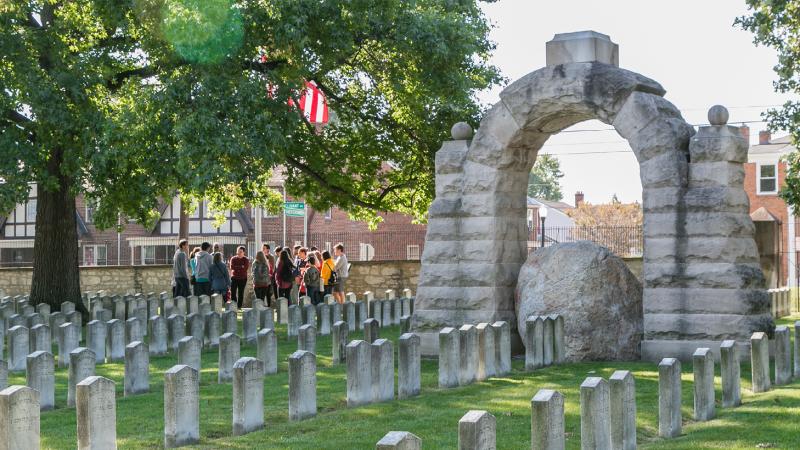Glimcher Distinguished Visiting Professor Walter Hood: Conflict, Memory and Landscape
In the shade of a sweetgum tree, 2017 Glimcher Distinguished Visiting Professor Walter Hood gathered with Knowlton School students in the Camp Chase Confederate Cemetery located in the Hilltop neighborhood of Columbus, Ohio. Surrounded by tombstones of Confederate soldier graves, the group discussed the nation-wide debate on the removal of Confederate symbols from public spaces. A recent act of vandalism at the cemetery, in which a Confederate soldier statue was toppled and decapitated, was considered against the history of an annual ceremony established in 1895 that honors those buried there. To the combined course of landscape architecture and city and regional planning students, Hood posed the question: “How do we talk about race in this context where you have a group of people who are still coming to this place, over a hundred years later, and saying this is really important to us?”

Prompted by their visit to the cemetery, the Glimcher Seminar students examined how designers and planners can engage with urban spaces that exist at the intersection of conflict, memory and the landscape. Guided by Hood through a series of seminar discussions, the students developed their research into a Banvard Gallery exhibition, Confronting Landscapes of Conflict, that engages the symbolic messages held by Confederate memorials, statues and cemeteries in communities across the country.
As creative director and founder of Hood Design Studio, Hood has confronted head-on issues of social justice and identity-related conflict. Several of these projects, such as Witness Walls, Nashville, Tennessee (2017), a public art piece that commemorates the city’s role in the Civil Rights Movement, and the landscape design concept for the International African American Museum, Charleston, South Carolina (2013 – Present), were highlighted by Hood during his Baumer Lecture at the Knowlton School on October 25, 2017. Hood noted that these two projects, along with others, are attempts to bear witness to a past in danger of being erased or forgotten.

As the students developed preliminary designs for the exhibit, Hood spent several days in seminar discussing and challenging their ideas. “He pushed the students to engage in confrontation; confrontation with their own feelings and beliefs about the Civil War, with the history of race and ethnicity in the United States,” stated City and Regional Planning Assistant Professor Mattijs van Maasakkers, co-instructor of the Glimcher Seminar, “and to view the gallery exhibit as an opportunity to force the visitor to engage in some of those same confrontations.” Co-instructor and Associate Professor of Landscape Architecture Kristi Cheramie added that the exhibit was a challenge for the students because it required them to put a verbal and visual language to questions of social justice.

"One of the biggest take-aways from the experience of working with Walter, and creating the pieces for the exhibition, has been the idea that with every decision you make about what to include, you are equally deciding what to exclude. Being conscious of erasure when reproducing visual representations of contested subjects, necessitates an extremely cyclical design/curation process,” commented Alexandra Lemke, a senior landscape architecture student. “This attention to erasure, and the implications of minutia in any representation of place, is a process that will follow me when the course is over."
Community engagement is a fundamental element that runs through many Hood Design Studio projects. “The models of practice that consult communities but don’t deeply involve communities in the design process and have that clear moment where the community voice is heard, have struggled to actualize their projects,” commented Cheramie. “Hood has identified this as a problem with the way that practices work with large community-based projects, and has found a way to not only incorporate their voices in visual, meaningful ways, but to use his own skills as a multi-disciplinary practitioner to give those voices an elevated form.”

In developing the exhibition, students engaged with various stakeholders of the Camp Chase Confederate Cemetery, speaking to representatives of organizations such as the Westgate Neighbors Association and the Hilltop Historical Society. These interviews informed the exhibition’s simulation activity, where participants assume hypothetical positions of interest to negotiate potential resolutions to a fictional cemetery’s incidents of contestation. Other elements of the exhibit include a taxonomy of icons that references Confederate monuments across the country, based on the Southern Poverty Law Center’s 2016 report Whose Heritage: Public Symbols of the Confederacy, and a fabricated wall that considers four of Hood’s projects and the cultural events and histories that informed these projects.
The 2017 Glimcher Exhibition, Confronting Landscapes of Conflict, is open to the public 9:00 a.m. – 5:00 p.m. from Friday, November 17 through December 15, 2017, in the Banvard Gallery located in Knowlton Hall.


